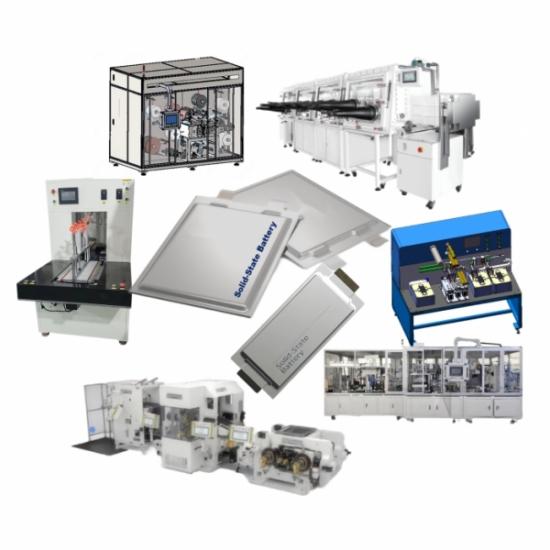Lith Corporation, founded in 1998 by a group of material science doctor from Tsinghua University, has now become the leading manufacturer of battery lab&production equipment. Lith Corporation have production factories in shenzhen and xiamen of China.This allows for the possibility of providing high quality and low-cost precision machines for lab&production equipment,including: roller press, film coater,mixer, high-temperature furnace, glove box,and complete set of equipment for research of rechargeable battery materials. Simple to operate, low cost and commitment to our customers is our priority.
What is a Car Battery Pilot Line?
A Car Battery Pilot Line refers to a smallscale, flexible, and semiautomated production system used to develop, test, and validate battery cell and pack manufacturing processes before fullscale commercial production begins. It serves as a bridge between laboratoryscale R&D and mass production, allowing companies to refine technologies, optimize processes, and reduce risks before investing in largescale gigafactories.
While a fullscale battery manufacturing or assembly line is designed for highvolume production (e.g., 10–100 GWh/year), a pilot line typically operates at lower capacities (e.g., 10–100 MWh/year) and is used for technology validation, process development, and product iteration.
Key Objectives of a Car Battery Pilot Line
1. Validate New Battery Technologies
Test new chemistries (e.g., NMC 811, LFP, solidstate, sodiumion)
Evaluate novel cell formats (e.g., pouch, prismatic, cylindrical, blade)
Assess new materials and electrode designs
2. Develop and Optimize Manufacturing Processes
Refine slurry mixing, coating, drying, stacking, welding, and testing
Identify process bottlenecks and improve yield and efficiency
Establish process control limits and quality standards
3. Enable Rapid Prototyping and Iteration
Produce small batches of battery cells or packs for vehicle testing
Quickly modify designs and test new ideas without disrupting mass production
4. Train Engineering and Production Teams
Provide handson experience for engineers, technicians, and operators
Build internal expertise in battery manufacturing
5. Support Technology Transfer to FullScale Production
Use data from the pilot line to scale up processes for gigafactories
Reduce timetomarket and minimize risks in largescale implementation
6. Comply with Automotive and Safety Standards
Ensure processes meet ISO 26262, IEC 62660, UN38.3, and other relevant standards
Validate safety, reliability, and performance of new battery systems
Types of Car Battery Pilot Lines
Depending on the focus and scope, pilot lines can be categorized as:
1. CellLevel Pilot Line
Focuses on the production of individual battery cells
Includes stages like:
Slurry mixing
Electrode coating and drying
Electrode stacking or winding
Cell assembly, electrolyte filling, and sealing
Formation, aging, and testing
2. ModuleLevel Pilot Line
Focuses on integrating cells into battery modules
Includes stages like:
Cell sorting and inspection
Module housing assembly
Busbar installation and welding
Thermal interface material (TIM) application
Modulelevel testing and traceability
3. PackLevel Pilot Line
Focuses on integrating modules into complete battery packs
Includes stages like:
Pack housing assembly
Cooling system integration
BMS installation and wiring
Highvoltage harness installation
Final pack testing and validation
4. Hybrid or FullStack Pilot Line
Combines cell, module, and pack assembly in a single flexible system
Ideal for startups, research institutions, and OEMs developing new battery platforms
Typical Components and Equipment in a Car Battery Pilot Line
Although smaller in scale, a pilot line includes most of the key equipment found in a fullscale line, but often with modular and flexible configurations.
1. Cell Production Equipment
Slurry mixer – For preparing cathode and anode materials
Coating machine – Applies slurry to current collectors (e.g., aluminum foil or copper foil)
Drying oven – Removes solvents under controlled conditions
Calender – Compresses electrodes to control density
Slitting machine – Cuts electrodes to size
Stacking or winding machine – Assembles electrode layers
Cell housing and welding system – Encapsulates the electrode stack
Electrolyte filling and sealing station – Fills and seals the cell under dry conditions
Formation and aging chamber – First charge/discharge cycle and stabilization
Testing equipment – Measures voltage, capacity, internal resistance, and cycle life
2. Module Assembly Equipment
Cell inspection station – Visual and electrical checks
Busbar welding system – Connects cells in series or parallel
Thermal pad applicator – Applies heatconductive materials
Module housing assembly line – Structural casing and brackets
Sensor and wiring installation – Adds temperature and voltage sensors
Module testing bench – Verifies communication, voltage balance, and thermal performance
3. Pack Assembly Equipment
Module loading system – Places modules into the pack housing
Cooling system integration station – Installs liquid cooling plates or air channels
BMS installation and wiring station – Mounts and connects the Battery Management System
Highvoltage harness installation – Adds main power cables and connectors
Pack sealing and leak testing – Ensures IP67 or higher protection
Final pack testing bench – Tests insulation, communication with ECU, and highvoltage integrity
Solid State Battery Machine
Supporting Infrastructure in a Car Battery Pilot Line
To ensure safe and efficient operations, several support systems must be integrated:
1. Clean Room & Dry Room Systems
Lowhumidity zones (<1% RH) for electrolyte filling and electrode handling
HEPA filtration to remove particulates
Climatecontrolled storage for sensitive materials
2. Fire Safety & Explosion Protection
Gas detection systems for solvent vapors and electrolyte leaks
Inert gas blanketing in solvent mixing and drying zones
Fire suppression systems using clean agents or water mist
Explosionproof enclosures for flammable processes
3. Digital Manufacturing & Process Control
MES (Manufacturing Execution System) – Realtime data tracking
IoT sensors and PLCs – Monitor pressure, temperature, humidity
AIbased vision systems – Detect defects in electrodes and cells
Traceability systems – Track every cell from raw materials to shipment
4. Waste Management & Sustainability
Solvent recovery systems – Reuse of NMP (NMethyl2pyrrolidone)
Battery recycling integration – Closedloop material recovery
Energyefficient HVAC and lighting
Water treatment systems – For cleaning and process water
5. Automation & Robotics
Automated conveyor systems – Move materials and components
Robotic arms – Handle electrodes, stack components, and load/unload machines
Laser welding and cutting – Highprecision joining and trimming
Smart testing systems – Autosort cells based on test results
Applications of a Car Battery Pilot Line
Pilot lines are used across a wide range of industries and organizations:
1. Startups and New Battery Companies
Develop and test new battery technologies before building gigafactories
Attract investors and partners with functional prototypes
2. Automotive OEMs
Build internal battery expertise and reduce reliance on suppliers
Customize battery packs for specific vehicle platforms
3. Research Institutions and Universities
Conduct advanced battery R&D and collaborate with industry partners
Train the next generation of battery engineers
4. Government and National Labs
Support national battery strategies and supply chain development
Promote innovation and technology transfer
5. Tier 1 Suppliers
Develop new battery components and systems for OEMs
Test integration with vehicle electronics and thermal systems
Benefits of a Car Battery Pilot Line
Accelerates technology development and commercialization
Reduces risks and costs in scaling up to full production
Supports innovation in battery chemistry, design, and manufacturing
Enables workforce training and process standardization
Strengthens local battery ecosystems and supply chains
Encourages sustainable and circular battery practices
Provides a competitive edge in the fastevolving EV industry
Leading Companies Involved in Car Battery Pilot Line Development
Here are some of the key players involved in designing and operating car battery pilot lines globally:
Battery Manufacturers:
CATL (China) – Operates pilot lines for nextgen battery R&D
BYD (China) – Blade battery development and testing
Panasonic (Japan) – Supports Tesla with cylindrical cell innovation
Samsung SDI (South Korea) – Highenergydensity battery development
ACC (France) – European pilot line for LFP and NMC batteries
Research Institutions:
Fraunhofer Institute (Germany) – Battery production research and pilot testing
Argonne National Laboratory (USA) – Advanced battery R&D and pilotscale work
Fraunhofer ISC (Germany) – Battery cell and pack development
CIC energiGUNE (Spain) – European battery innovation center
KRICT (Korea Research Institute of Chemical Technology) – Battery chemistry and process development
Equipment and Automation Providers:
KUKA (Germany) – Robotics and automation for battery assembly
Siemens (Germany) – MES and digital twin platforms
Trumpf, Coherent, IPG Photonics – Laser welding and cutting
Hanson Robotics, Gree EnergyTech – Integrated battery line solutions
B&R Automation (ABB subsidiary) – Smart manufacturing systems
Engineering and EPC Firms:
Bechtel, Hatch, Black & Veatch – Turnkey plant construction
Wood, Jacobs, GHD – Engineering and sustainability consulting
Need Help Designing or Optimizing Your Car Battery Pilot Line?
If you're looking to build, expand, or optimize your car battery pilot line, I can help you with:
Master planning – Site selection, process flow, zoning
Process engineering – Battery chemistry, format, and production stages
Factory layout design – Clean/dry room integration, workflow
Equipment sourcing – Bestinclass machinery and automation
Sustainability strategy – Green energy, recyclability, circular economy
Cost estimation and ROI analysis – CapEx, OpEx, breakeven modeling
Compliance and safety systems – Fire protection, permits, worker safety
All you need to do is provide the following information:
Battery chemistry and cell format (e.g., NMC, LFP, solidstate, pouch)
Target annual production capacity (e.g., 10–100 MWh/year)
Plant location and available infrastructure
Level of automation and digitalization desired
Current team expertise and strategic goals




 Online service
Online service
